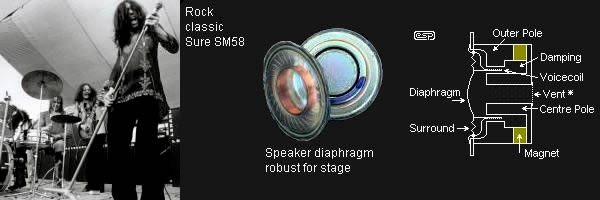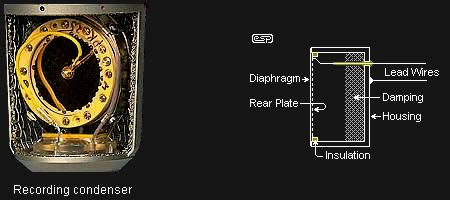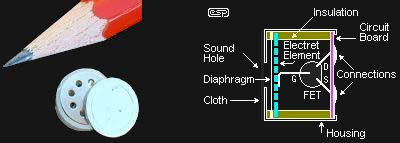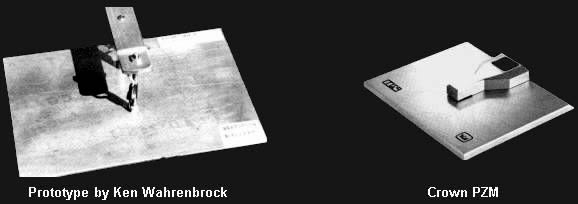Dynamic stage mics are magnetic mics constructed in the same way as a small loudspeaker, often with a very light Mylar diaphragm. This design based on a loudspeaker construction is the most robust especially from spitting, dropping and screaming, and therefore popular with stage musicians. Most are cardioid, although omni-directional are available.
A diaphragm is coupled to a voice-coil that is suspended in a strong magnetic field. As the diaphragm (and thence the coil) moves in sympathy with the sound waves, an electric current is generated. In a perfect microphone, the electrical current will be an exact replica of the acoustic signal, but in reality this is never the case.

The element (also known as a capsule) shown has a vented pole-piece (indicated with a *), and this is typically done to create the required directional characteristic. For an omni-directional dynamic microphone, the back would be sealed.
Dynamic mics are similar to the construction of a small speaker, and a speaker will work as a microphone. Naturally, the speaker and mic are each optimised for their intended application. The majority of intercom systems use the speaker as a microphone and vice-versa.
A typical dynamic mic is easily capable of 0.5V RMS (500mV). This may seem extreme, but the specification for the SM58 is 1.85mV at 1 Pascal (94dB SPL), so 185mV results at 114dB SPL. Therefore 500mV is achieved at just under 123dB SPL which many loud vocalists can achieve with the mic held at close range, at their lips or in their mouth.
Good mic technique includes 'pulling back' from the mic when singing loudly, and getting in close for soft passages. But unfortunately there are many pop/rock singers that don't have an understanding or feel for mic technique.
At these levels, one can completely forget using electret mics, as they will readily distort. Electret mic sensitivity is much higher than a typical dynamic mic. The electret mic may attempt to produce 3V to 5V RMS at the same SPL (123dB), which is not possible with standard electret capsules, especially if powered by an internal 1.5V battery.
Typical dynamic microphones have an impedance of around 150 - 300 Ohms, although some are higher or lower than that. While it may seem tempting to match the impedance of the microphone and preamplifier, this is ill advised, as it will reduce the signal level by 6dB, and thus reduce the signal to noise ratio.
Ribbon microphones
Ribbon microphones are also magnetic and have very thin (usually aluminium) ribbon (almost zero mass) suspended between the poles of an intense magnetic field, and generates a small electric current when it is moved by sound. A ribbon mic is very similar in construction to a ribbon tweeter. Ribbon mics have special place in the hearts of many old recording engineers. They are mechanically very fragile. However there are later designs that are robust. Because ribbon mics use a relatively large diaphragm (much larger than most other mics), they can be very sensitive to air movement - especially at subsonic frequencies.

Ribbon mics have an inherent figure-8 pattern, (open front and rear) although this is often modified to produce more 'conventional' patterns. Because the impedance of the ribbon is extremely low (less than 1 Ohm), a transformer is used to raise the impedance and output voltage to a usable level. The transformer is often in the same housing as the microphone. Because of relatively low output level (even after the transformer), a very quiet pre-amp is required. They have very low self noise, so pre-amp noise can easily exceed the microphone noise.
Ribbon mics are not negatively effected by high SPL. Provided the ribbon remains in the gap, almost nothing will cause a ribbon mic to distort. However direct air movement (from breathing or blowing) can distort the ribbon, which then must be replaced.
www.lkmusic.co.nz/ribbonfix.htm
Tutorial Build a Ribbon Microphone
www.vintage-microphones.de Ribbon repair
'Planar ribbon' mics are a variation of the theme and are not a ribbon in the true sense of the term. These use a thin membrane with a planar (flat) metallised coil printed on a thin plastic carrier. These are very rugged according to the literature.
Capacitor Microphones
Historically, these mics have been known as 'condenser' mics. 'Condenser' is the old term for a capacitor. Capacitor mics are the backbone of the recording industry. 'Neumann U47' is the most recognised name. They have exceptional detail, and can usually tolerate very high sound levels. Distortion is very low, because the diaphragm movement is so small (comparable to that of the human ear drum).

Capacitor mics use a high DC voltage to polarise the 'plates' of the capacitor sensor, although some use the change in capacitance to modulate a radio frequency oscillator. The frequency modulated 'carrier' is then fed to a detector stage to be converted back to audio. Capacitor mics (of all types) require power - this may be supplied via the P48 (48V phantom feed) from a mixing desk, or may be an external power supply. Voltages up to 200V will be found in some examples.
A capacitor microphone is mechanically very simple, but the material quality is critical for good performance. Because the capacitance is so small (approx 80pF), the insulation resistance must be very high, as must the impedance of the following stage. It is not uncommon to find in excess of 100 Meg ohms input impedance for the impedance conversion stage. This places great constraints on the insulation, which is adversely affected by moisture.
The diaphragm of capacitor mics is conductive, and often use metallised plastic film (Mylar is popular). The metallisation film must be protected from moisture, and in most designs is on the inside of the capsule. The insert will have a tiny bleed hole to allow the air pressure inside the housing to match that of the outside atmosphere.
Many condenser mics use a dual diaphragm capsule, and switch one diaphragm to change the directional characteristic from omni-directional to cardioid. In some cases, the microphone capsule may have two diaphragms, each spaced as close as possible to the back-plate. This will create a microphone with a figure-8 directional pattern.
Excellent pics of condenser mic diaphragms and repairs
www.pelusomicrophonelab.com
Electret microphones
Electret microphones are also called 'Electret Condenser' or 'Electret Capacitor'. These mics use the same general principles as a capacitor mic, except they use a permanently 'charged' plastic membrane so that a high voltage polarising signal is not needed (as is the case with true capacitor mics). Professional electret microphones are excellent for recording. But the majority are unsuited for high SPL.
Instead of needing an external DC polarising voltage, the back-plate is an electret material (this is a so-called 'back electret' hence the name). This material is a plastic that is subjected to an intense electrical field during processing. This causes the plastic material to retain a charge (more or less) permanently. The electret surface are metallised to make it conductive. Some electret mics use the diaphragm as the electret element (and use a conventional back-plate), and while this works very well, they do not have an indefinite life.

The FET (Field Effect Transistor) shown is almost always included in the capsule itself. This is the impedance converter, and in most cases there is no resistor from the gate to common (ground, mic housing). The FET gate circuit relies on surface leakage alone to bias the FET correctly. This is one reason that electret mics can react badly to sudden loud sound, and may lose sensitivity for a few seconds.
Electrets' can be used for stage work, they may (or will) distort at high sound pressure level (SPL). Loud vocalists can easily drive electret mics into distortion at close range. Also temperature and humidity (from the breath of vocalists) can adversely affect them.
The majority of electret mics are omni-directional. Cardioid inserts are available as well as multiple inserts to create different patterns.
Electret mic capsules only cost a few cents to make. Made in the countless millions they are the most common unseen microphone used in the world, mobile phones, computers the list is endless.
PZMTM Pressure Zone Microphone (Boundary Mic)
PZM (also known as a boundary mic) is a special application of the electret mic. A miniature electret sensor is mounted a small distance (less than 1mm) facing towards a flat plate. They are often used on floors, walls, tables for conferencing, and can be attached to any large flat surface.
wiki/Boundary_microphone
The PZM has exceptional performance that closely resembles our hearing. The PZM is flat and is designed to be mounted to a wall or placed on the floor or a table top. The bigger the boundary underneath the microphone, the better it will perform. When applied the polar response is hemi-spherical.
There are many variations on the basic design, that allow for a single stereo mic unit. A cheap version was supplied by Radio Shack, but lacked the true characteristics of the original PZM.

History of PZM www.uneeda-audio.com/pzm/
"In 1978 sound engineers Ed Long and Ron Wickersham recognized the effects of a boundary layer in sound recording. In studying the behaviour of flush mounted microphones, they discovered that within a few millimetres of a large surface, sound levels from a pair of equal level signals add coherently because, in close proximity to the surface, the particles are still in phase as they accelerate after being brought to a stop by the boundary, thus creating what is called a pressure field, or pressure zone, in the boundary layer. The result is a 6 dB increase in acoustic pressure."
Written by Chris Steinwand www.svconline.com/news/boundary-microphones
There were AB demonstrations that proved many pop recording engineers could not hear the difference between some of the best know condenser mics and new PZM. For those of us that understood the PZM technology it proved how good many condenser mics were. The PZM is possibly the closest transparent recording device that does not appear to have its own sound.
It was thought at the time that the extraordinary performance of the PZM would make the majority of studio recording microphones obsolete (except for hand held mics) and revolutionise the recording process. But the pop recording industry is blinded by conformity, image, trends and fads, and very resistant to technological advancements and change.
Transmitting mics are available in many variations. Transmitting mics for professional application can be very expensive. Mostly used for live dance musical productions and television. They require specialist knowledge and experience to use them correctly, which will be later covered on this page. Many transmitting mics have internal automatic compression/limiting that unfortunately restricts the dynamic expression of good singers, causing them to sound flat and lifeless.
Phantom Power
In the late 1960s, Neumann converted its valve (tube) capacitor microphones to solid-state. They decided upon a remote powering system called 'Phantom Power', which is a trade mark of Neumann. Although other manufacturers originally avoided the trade mark (using terms such as 'simplex' instead), over time the term 'Phantom Power' has become generic. DIN standard 45596 describes the powering of any device that uses the P48 phantom powering scheme.

The phantom feed supply voltage has been standardised at 48V, but there are many supplies that do not comply, with some operating at 30V or even less. The accepted voltage range for P48 is between 38V and 52V. A 'new' sub-standard has arisen, called P24 (20V - 26V), but this is a seriously retrograde step, creating potentially disastrous incompatibilities between competing standards.
Because phantom power is a common mode signal (it appears equally on both mic leads), plugging a balanced dynamic mic into a 'live' P48 powered mixer channel should not harm the microphone. The mic may make strange loud rude noises if the internal insulation is degraded (by age, saliva, beer, rum+coke, etc.). Always switch off the P48 supply unless it is not needed.
Phantom powering is not the only way that power is supplied to microphones. Another standard is called T12 - as well as transverse feed, A-B powering, parallel powering, and occasionally by its full name ... 12V Tonader (it originated in Germany). It is not commonly found outside the film industry, and is totally incompatible with P48 powering. Adaptors can be fabricated, but require a transformer.
The T12 system uses 180 ohm feed resistors and a 12V supply, but the DC is not sent as a common mode signal like phantom feed. Referring to an XLR mic connector, the positive DC is applied on pin 2, negative on pin 3, and earth (ground) on pin 1. However, there is also a reverse version, with positive on pin 3 and negative on pin2. T12 powering will probably damage dynamic mics that are inadvertently connected while the T12 power is on.
Capacitor microphones using valves (tubes) will almost always require a special outboard power supply, and multi-pin connectors are common. Because of the larger current needed by the valve heater, the 2 - 4mA available from P48 is completely unsuitable. These power supplies will be specific to the microphone and there is possibly no standard adopted by manufacturers, so each may be different.
Written by Rod Elliott (ESP Elliott Sound Products) sound-au.com/articles/microphones.htm
Basic Specifications
Output level of Mics are rated in milli-volts per Pascal (mV /Pa)
1Pascal = 10micro-Bar = 94dB SPL
Average speech at 1 Meter = 0.1Pascal = 1micro-Bar = 74dB SPL
Links
Excellent large data base of microphone information.
www.recordinghacks.com
Comparison mp3 demonstration of mics
www.coutant.org
www.coutant.org/contents.html
www.coutant.org/allmics
History of mics.
micpedia.com 'History of mics'
wikipedia.org Stereophonic sound
Early Creators of outstanding recordings.
Wiki Orson Welles 'War of the Worlds'
Wikipedia.org Stan Freberg
Wikipedia.org George_Martin
www.beatlesagain.com/bgeorgem.html
www.beatles.com
Wiki Seargent Peppers 1967 recording technology
Independent Microphone applications and Data
Wikipedia Microphones
Wikibooks Microphones
David Griesinger The Physics and Psychophysics of Surround Recording
schlemmer.gmxhome.de Introduction to Sound Recording
www.microphone-data.com
www.oktavausa.com Russian mics with excellent pics
Microphone manufacturers and suppliers The majority of sites have vast and useful information,
www.akg.com
www.audiomaster.cz AKG Recording Applications pdf
www.appliedmicrophone.com
www.beyerdynamic.com
www.dpamicrophones.com The DPA Microphone university page.
www.electrovoice.com
www.mannelectronics.com
www.neumann.com
www.royerlabs.com
www.rycote.com
www.schoeps.de
www.shure.com
www.sennheiser.com


